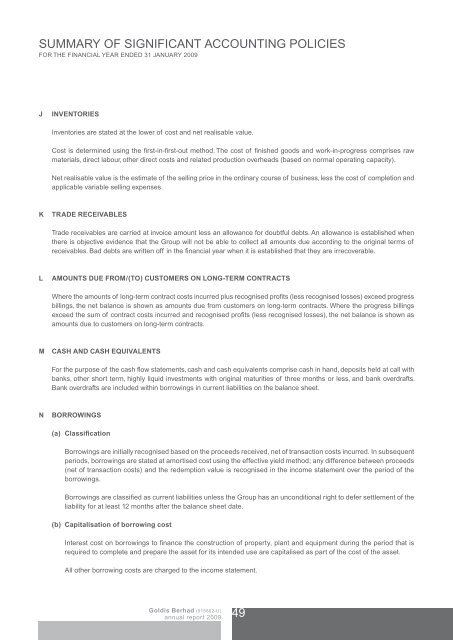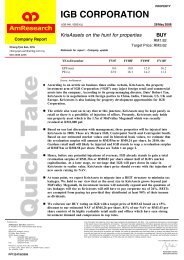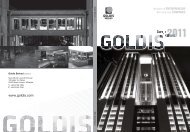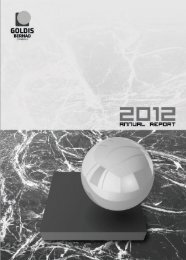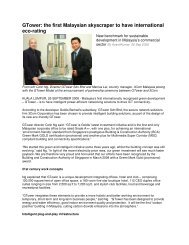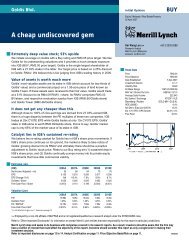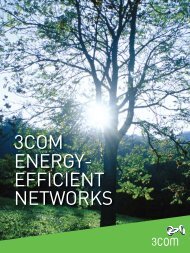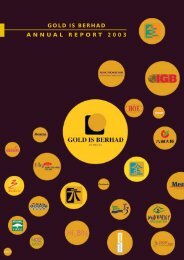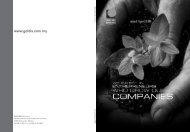Goldis Berhad Annual Report 2009
Goldis Berhad Annual Report 2009
Goldis Berhad Annual Report 2009
Create successful ePaper yourself
Turn your PDF publications into a flip-book with our unique Google optimized e-Paper software.
SUMMARY OF SIGNIFICANT ACCOUNTING POLICIES<br />
FOR THE FINANCIAL YEAR ENDED 31 JANUARY <strong>2009</strong><br />
J<br />
INVENTORIES<br />
Inventories are stated at the lower of cost and net realisable value.<br />
Cost is determined using the first-in-first-out method. The cost of finished goods and work-in-progress comprises raw<br />
materials, direct labour, other direct costs and related production overheads (based on normal operating capacity).<br />
Net realisable value is the estimate of the selling price in the ordinary course of business, less the cost of completion and<br />
applicable variable selling expenses.<br />
K<br />
TRADE RECEIVABLES<br />
Trade receivables are carried at invoice amount less an allowance for doubtful debts. An allowance is established when<br />
there is objective evidence that the Group will not be able to collect all amounts due according to the original terms of<br />
receivables. Bad debts are written off in the financial year when it is established that they are irrecoverable.<br />
L<br />
AMOUNTS DUE FROM/(TO) CUSTOMERS ON LONG-TERM CONTRACTS<br />
Where the amounts of long-term contract costs incurred plus recognised profits (less recognised losses) exceed progress<br />
billings, the net balance is shown as amounts due from customers on long-term contracts. Where the progress billings<br />
exceed the sum of contract costs incurred and recognised profits (less recognised losses), the net balance is shown as<br />
amounts due to customers on long-term contracts.<br />
M<br />
CASH AND CASH EQUIVALENTS<br />
For the purpose of the cash flow statements, cash and cash equivalents comprise cash in hand, deposits held at call with<br />
banks, other short term, highly liquid investments with original maturities of three months or less, and bank overdrafts.<br />
Bank overdrafts are included within borrowings in current liabilities on the balance sheet.<br />
N<br />
BORROWINGS<br />
(a) Classification<br />
Borrowings are initially recognised based on the proceeds received, net of transaction costs incurred. In subsequent<br />
periods, borrowings are stated at amortised cost using the effective yield method; any difference between proceeds<br />
(net of transaction costs) and the redemption value is recognised in the income statement over the period of the<br />
borrowings.<br />
Borrowings are classified as current liabilities unless the Group has an unconditional right to defer settlement of the<br />
liability for at least 12 months after the balance sheet date.<br />
(b) Capitalisation of borrowing cost<br />
Interest cost on borrowings to finance the construction of property, plant and equipment during the period that is<br />
required to complete and prepare the asset for its intended use are capitalised as part of the cost of the asset.<br />
All other borrowing costs are charged to the income statement.<br />
<strong>Goldis</strong> <strong>Berhad</strong> (515802-U)<br />
annual report <strong>2009</strong><br />
49


